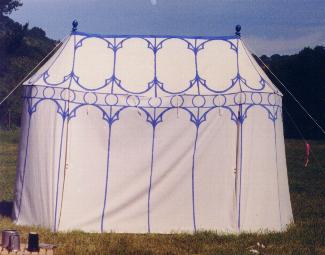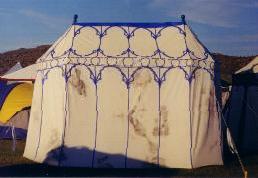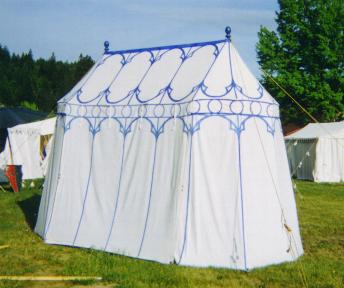


When I opened the bag a month later, I found to my dismay that the sidewall panels of the tent were covered with mildew. (The canopy, made of mildew-resistant Sunforger, was still in perfect shape). I gazed bleakly at the damage and thought of the dozens of hours I'd spent in painting the design. I was not a happy camper.

The material tested was a 6.5 oz cotton/polyester twill with no finishing process. The paint is Versatex fabric paint purchased from the Dharma Trading Company and heat-set using a commercial clothes dryer, as described on the label (and verified by a call to their customer service representative). I expect that the mildew infestation is typical of this type of cloth, as well as untreated all-cotton cloths.
Please note that mildew thrives when it finds some sort of organic food source on the fabric. It multiplies and excretes the stuff that actually causes the stain. The organic food doesn't have to be the cloth itself ... it can be organic matter on the tent such as dirt, spilled beer, or whatever. Therefore, all cloth, even synthetic cloth, is therefore susceptible to mildew damage, even it's specifically been treated with mildew-retardant chemicals, as long as there's something for the mildew to eat. Mildew-retardant fabrics do make it a lot harder for those little buggers to survive, but I've seen mildewed Sunforger and mildewed Pyrotone.
What follows are descriptions of the various treatments, and what I found when I used them. Please note the following caveats:
Caveat #1: I'm using a numerical rating system to help you compare the treatments. The range of these numbers is from Zero (for "didn't do squat") to Five (for "left cloth as good as new, or even better"). These numbers are not the result of careful testing, using photographs, reflective/absorptive technology, or any of the other fancy stuff that Consumers Union uses when documenting their product reviews, because I don't have their budget. To be blunt about it, I assigned the numbers arbitrarily. So something that rates a 3 isn't twice as effective as something that gets a 1.5 --- all it means is that it seemed to work better than something that earned a 2, and not as well as something that earned a 4. I suspect that Roger Ebert ranks movies like this.
Note that nobody got a 5, although some came pretty close.
Caveat #2: I make no claim about how much any of these treatments will weaken the fabric. I suspect that some deterioration will occur, based on what I've seen bleach do to other fabrics. But I haven't tested this specifically, and I don't intend to. Instead, I'll just keep an eye on the cloth and see which sections seem to be holding up better.
Fact is, I didn't much care how badly the fabric was going to rot. As it was, the cloth was so unsightly that I had already written it off. But if I had to choose whether to have an ugly but structurally sound cloth and a pretty but structurally damaged cloth, my choices might have been different.
I applied the treatment as described in whatever literature that accompanied the product, if it mentioned any use of it on fabric or canvas. If the product didn't mention a specific method for fabric, I did whatever seemed right. I then gave the product about fifteen minutes to make an observable difference. If it seemed to be working, I gave it another treatment using the same method. If it didn't, I used another treatment.
All areas were thoroughly rinsed, and rinsed, and rinsed again, using the setup I described in my column on cleaning tents. Then all the fabric was allowed to dry. Finally, I did a crude "poke test" to see if the fabric had become friable. All the treatments survived this test, but I'll reiterate that I make no claims about how this fabric is going to age in months to come.
Vinegar and Borax: This is a treatment I got off the Internet. (There's a similar formula involving lemon juice and Borax that pops up in many books on cleaning.) The attraction is that it didn't cost much. But it had practically no effect on the mildew stains. In fact, I was concerned that the vinegar might be acting as a mordant, helping to fix the discoloration into the cloth. But my wife, who does a bit of natural dying in the textiles she creates, doubted that the vinegar would have much of an effect at the temperatures I was using. Rating: 0.5
Shower Power from Powerworks Company: I used this on the recommendation of a fellow tentmaker, who had heard about this but hadn't actually tried it. Well, I tried it. It was a waste of money, as far as removing the stains went. To be fair, I must concede that this product was made for things like bathroom stalls, not fabric, and I suspect that it would work far better on tile and grout and stuff like that. I also suspect that most of the stuff intended to be used in shower and bath fixtures would fare about the same. No damage to painted areas. It left a strong sulfur odor, which persisted faintly even after both rinsing and subsequent treatments with other products.Rating: 0.5
Starbrite Sail & Canvas Cleaner: I got this stuff from West Marine, a marine products chain with several locations. Other marine supply companies sell a similar product. It's really a detergent, not a bleach. It foamed up real nice, but didn't make much of an impression on the mildew stains. It made the rest of the cloth nice and clean, though. I'd probably recommend it for cleaning tents if I thought that it was enough of an improvement over dish soap to justify its greater cost, but it wasn't that much better. No damage to painted areas. Rating: 1.0
OxiClean: This product, from Orange Glo International, also didn't specifically mention canvas, so I was left to my own ingenuity. It was recommended to me by somebody who occasionally uses it, in greatly diluted form, in her job in textile conservation and restoration. I mixed it up at the recommended strength and let the piece soak in it for twenty minutes or so. It seemed to do some, so I gave it a little longer. It did a fair job of getting the worst of the stain off, but left a distinct area where the stain was worst. Of all the products that actually seemed to get the job done, it did the least damage to the paint job. Rating: 3.5
West Marine Mildew And Stain Remover: Again, bought from West Marine, but they had a few other products on their shelf that seemed identical and at about the same price. Other marine supply stores have their own brands which seem to be comparable. This stuff's active ingredients are sodium hypochlorite (otherwise known as chlorine bleach) and sodium hydroxide (also known as caustic soda, liquid caustic, lye, soda lye, sodium hydrate, and other names). Like some of the other products, it didn't specifically mention canvas, but it did say it was good for boat covers, many of which are fabric, so I figured I'd give it a go. You spray it on, leave it on until the stain goes away, and rinse. No scrubbing required. It worked very well on the tent. There were some areas that required a second application, and once rinsed off, it left a slight discoloration on the fabric. The paint faded significantly on those areas treated by this product. Rating: 4.0
Chlorine bleach, mixed 1:5 with water and applied by spray bottle: I figured that since I had some chlorine bleach in the laundry room, I'd try my hand at mixing up a home-brew version of the previous product. It worked about as well as the store-bought kind, although not as quickly. A stronger concentrate might have worked identically, so I'll give it the same rating: Rating: 4.0
Chlorine bleach, mixed 1:8 with water and applied with a scrub brush: The winner, although it did require some elbow grease. The scrubbing helped work the solution into the weave, which helped it make contact with the deeper parts of the stain. The trick here is patience ... it sometimes takes ten or fifteen minutes for the bleach to work. The worst areas had to be done two or three times. There was a little residual discoloration, and significant fading where the painted areas were treated. I recommend soaking all the fabric, not just the parts that got mildewed, because otherwise it's very easy to see the parts that got spot-treated because they're much whiter than the adjacent sections (except for the specific areas that were worst affected by the mildew stain). I also recommend using rubber gloves on your hands to avoid skin irritation. I didn't, and wished I had later when the chlorine left reddened areas on my fingers that looked a little like first-degree burns.Rating: 4.5
